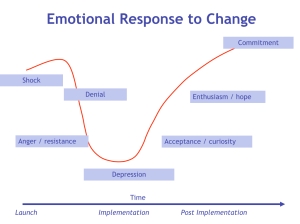 The Kübler-Ross change curve is often cited as an emotional mapping of the resistance that generally we have to change. Elisabeth Kübler-Ross had spent many years working with individuals with terminal illnesses and also with their families. In doing so, she identified several emotions that were commonly emerging for the patients. They often found themselves in shock and then denial, they would become angry, they would bargain for more time, they would become depressed and maybe, just maybe they may come to accept what was happening to them. And throughout that time they would have an underlying hope that a miracle would occur and they would be spared. Ultimately many patients would enter a period of decathexis, where they would disconnect emotionally. Kübler-Ross saw these different stages as part of the coming to terms with dying, and the stages are where the simplified curve has been adapted from.
The Kübler-Ross change curve is often cited as an emotional mapping of the resistance that generally we have to change. Elisabeth Kübler-Ross had spent many years working with individuals with terminal illnesses and also with their families. In doing so, she identified several emotions that were commonly emerging for the patients. They often found themselves in shock and then denial, they would become angry, they would bargain for more time, they would become depressed and maybe, just maybe they may come to accept what was happening to them. And throughout that time they would have an underlying hope that a miracle would occur and they would be spared. Ultimately many patients would enter a period of decathexis, where they would disconnect emotionally. Kübler-Ross saw these different stages as part of the coming to terms with dying, and the stages are where the simplified curve has been adapted from.
What seems odd in the original model was that Kübler-Ross left out fear, along with shame, guilt and sadness (as opposed to depression), all of which would seem to have their place. She did write about the fear of dying in her book ‘On Death and Dying’, but wrote in terms of the fact that in the western world we have a fear of death that is hot helpful and it didn’t make it as a stage within her model. Maybe the patients that Kübler-Ross included within her writing didn’t communicate any fear that they may have had. Somehow, from what she did write about, we have ended up with a simple Kübler-Ross change curve that leaves out hope, fear, bargaining and decathexis.
The emotional change that happens when most people face adversity probably incorporates the emotions that Kübler-Ross wrote about, but generally fear plays a big factor, with anxiety as one of the biggest barriers to remaining resilient. Obviously if you know that you’re dying, overcoming that anxiety is not going to be easy, but for most of us going through change, finding some certainty for ourselves in our future can dispel some of that fear.
Creating goals for ourselves, and then redirecting our focus and emotional energy towards them, can be a useful way of lessening the damaging impact of change and the emotions involved in the change curve, if indeed we see it as a curve at all. After all, Elisabeth Kübler-Ross never did.